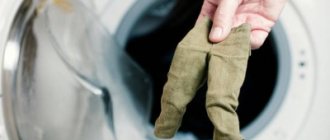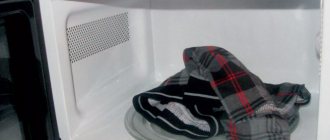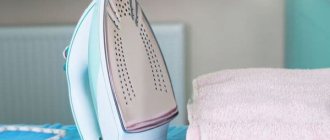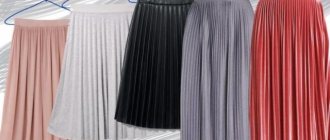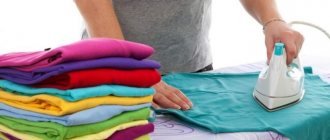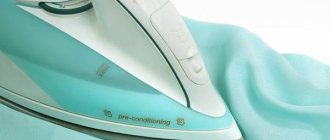With the birth of a child, a woman, in addition to joy, is faced with a lot of worries. And here you need talent to correctly prioritize.
In addition, it is necessary to have knowledge on optimizing the process of household chores. Perhaps some of them are completely useless? For example, ironing children's clothes.
Is it necessary to iron baby clothes after washing on both sides? Is it necessary to do this for newborns and for how long? You will find answers to questions in the article.
Points for and against"
Today, there is no consensus among medical professionals regarding the need to iron children's clothes. Old-school pediatricians actively recommend that young mothers carefully iron their clothes.
The opinion is justified by the fact that:
- harmful microbes are destroyed;
- Residues of detergent are removed;
- the fabric and seams on clothes become softer;
- the service life of things increases;
- the need for beauty and neatness is satisfied.
No scientific research has been conducted on these items, and the benefits of ironing are rather questionable . For each of the arguments, you can give a counterargument, and more than one.
Undoubtedly, with the arrival of a newborn, the physical load on a tired mother increases significantly. In maternity hospitals, diapers and clothes for newborns are not subjected to heat treatment after washing.
Modern pediatricians say that ironing children's things is possible, but not at all necessary.
The arguments against ironing are that:
The baby does not need sterile conditions, so if possible, the newborn is immediately placed next to the mother and discharged from the hospital within 2–3 days. In this case, the baby is populated by the microflora of loved ones and the home environment. This tactic contributes to the normal formation of the child’s immunity.- Children under 1–1.6 years old relieve themselves in diapers, then in their pants, and soil their blouses. If you do not use diapers, then a huge amount of laundry will accumulate during the day, which is difficult to process.
- If you use special detergents for washing children's clothes and rinse thoroughly, then there is no need for ironing.
Doctors advise ironing clothes from the inside without fanaticism in the following cases:
- until the umbilical wound has healed;
- if there are inflammatory processes on the navel or skin.
New items purchased for a baby must be washed and ironed before use. In the future, the ironing procedure is carried out if possible and desired.
Is it necessary to iron things for a newborn - the opinion of a neonatologist in this video:
Reasons to wash new bedding
Experts explain to consumers why this procedure is strongly recommended:
- Once manufactured, most bedding sets go through the process of being packaged in polyethylene bags, which are not airtight. Even if the integrity of the package is not in doubt upon purchase, there is a possibility of bacteria and allergens getting on the fabric. They can cause significant harm to the body.
- If you thoughtlessly lay out a set of natural fibers immediately after purchase, you run the risk of ending up in the same bed as dust mites. Their size is very small; it is unlikely that parasites will be visible to the naked eye. Mites living on fabric can cause severe allergic reactions and cause inflammatory diseases of the respiratory tract.
- Many manufacturers try to give their products a spectacular and presentable look. For this purpose, fabrics are treated with specialized compounds that provide additional rigidity to the material and enhance the brightness of the colors. In addition, unscrupulous sellers use unstable dyes. These compounds will not cause much damage to the body, but can provoke unpleasant allergic skin reactions and leave stains on home clothes.
Why do you need washing?
Often, the manufacturer already indicates in the instructions whether new bed linen should be washed before first use. Washing will remove industrial dust and chemical impregnations. The fabric will become soft, breathable, and acquire a pleasant aroma of fabric softener. It will be safe and comfortable to sleep on it.
Rules for first washing bed linen
Strict adherence to the manufacturer's recommendations for textile care will allow you to maintain the original presentable appearance of the product. Its colors will delight you with brightness, and the shapes of duvet covers, pillowcases and sheets will remain even, without unexpected shrinkage or deformation.
The first wash of bed linen has some nuances:
- You should not try to wash several sets together. If one of them fades, it can hopelessly ruin all things.
- Hand washing or gentle cycle for delicate fabrics in an automatic washing machine will be the best option for the first treatment of the fabric. The optimal spin mode is no more than 600 rpm.
- It is recommended to turn the duvet cover and pillowcases inside out. It is useful to follow this advice in subsequent washes. In this way, the products are protected from possible faded stains.
- If the manufacturer has not specified other requirements, then it is better to use cold water no more than 40 degrees.
- For washing, it is better to use liquid gels and powders. They remove possible contaminants more carefully. The use of bleaches, softeners and stabilizers is contraindicated.
- When calculating the optimal volume of detergent, you should be guided by the weight of the bedding set. On average, a one-and-a-half cotton set weighs about 1.6 kg.
- There is no point in vigorously rubbing the fabric and twisting it with unnecessary effort. It is recommended to lightly wring out the product and hang it to dry in the open air.
- Using a special fabric softener will add fragrance and softness to your bed linen.
Up to what age and why?
From a medical point of view, ironing baby clothes can be justified until the navel has completely healed, that is, until the age of 2–4 weeks. However, if you properly care for the wound, wrinkled clothing does not pose any danger to it.
Women's practical experiences demonstrate diversity to the extreme. For example:
- careful ironing of children's clothes throughout their lives;
- until the baby is 1–3 months old;
- up to six months, a year, 2–3 years;
- exclusively for “exit”;
- They don't iron at all.
How many families, so many options. In this matter, every woman has the right to her own position. The only unanimity noted is that going for a walk, going to the clinic, or seeing guests necessarily requires ironing clothes.
How to do it correctly, safely and comfortably?
If for some reason there is a need for regular ironing of children's clothes, then it makes sense to make this labor-intensive process more comfortable and enjoyable:
- Buy good equipment for the job. An iron with a steam generator function, an automatic temperature control system and a high-quality ironing board will reduce the time it takes to process products.
- If you have a regular iron in your arsenal, then you need to sort things by type of fabric and adjust the temperature for each pile.
Manufacturers attach a label to each type of clothing indicating the washing and ironing conditions.
To prevent the product from losing its appearance over time, you should not exceed the temperature limits for different fabrics:
linen — 1900–2000;- cotton — 1100–2000;
- wool — 1400–1650;
- natural silk — 1150–1400;
- viscose — 850–1150.
Knitted items are often present in a child’s wardrobe. This fabric loses its shape after washing and ironing, so this item is ironed from the inside out while slightly damp.
In this case, you do not need to actively move the iron, but gently apply it to the fabric. Children under 5 years old are not recommended to use synthetic items.
When ironing is necessary
There are a number of cases when the issue of the need for ironing is resolved by itself.
It is necessary to iron bed linen in the following cases:
- If there is a small child in the house. Pediatricians strongly recommend ironing all elements of the bedding set for both the newborn and his parents. This will protect the baby from infections and germs, encounters with which are very undesirable at this period of life.
- During illness. Ironing clothes is necessary during colds and skin diseases (lichen, dermatitis, various types of fungus). The set with which the patient came into contact must be washed at temperatures above +60 ℃, and then ironed with steam.
- Arrival of overnight guests. It is unlikely that you will want to make their bed with rumpled duvet covers and sheets. It’s better to worry in advance and always keep one or two ironed sets in reserve. This way you will avoid awkwardness and establish yourself as a hospitable hostess.
An infant's bedding must be ironed
There are alternatives!
In addition to various models of irons, the modern market offers high-tech mechanisms for quickly and efficiently putting things in order.
Along with the inventions of the century, there are simpler and more economical ways to iron clothes. Each of them has its own advantages and disadvantages.
The table shows alternative devices and methods of ironing without an iron:
| Name | pros | Minuses | How to use | Price |
| Steam generator |
|
| According to instructions | From 2 to 40 thousand rubles. depending on model and manufacturer |
| Steamer |
|
| According to instructions | From 1 to 10 thousand rubles. depending on model and manufacturer |
| Steam | Does not require financial costs | Long wait for results | Hang items over a bathtub of hot water for 20 minutes. Wait until dry. | For free |
| Hot mug |
| You may get burned. | Fill a metal mug with boiling water and iron the item. | For free |
| Special solution |
|
| Pour a mixture of equal parts of 9% vinegar, water and fabric softener into a spray bottle, spray on clothes, and let dry. | From 200 rub. |
| Wet towel | Economical |
| Carefully lay the item on a towel, wait until it straightens out, and hang it on a hanger. | For free |
| Wet hand | Economical | Suitable for minor uneven surfaces. | With a wet hand, run along the folds. | For free |
Is it possible not to iron bed linen: objective facts
Creases are not only disappointing, but they also give an unpleasant and dirty appearance to both the bed and the room. Ironing bed linen, especially for a large family, is a difficult and time-consuming process. Once upon a time, clothes were washed, boiled, starched and only then ironed. The pace of life accelerated, sophisticated washing machines with dozens of functions began to appear, and starch was declared completely harmful.
Arguments for:
- The fabric becomes softer.
- They prefer to give their dear guests ironed linen rather than wrinkled linen.
- The appearance is greatly improved.
- Ironing prevents the fibers from splitting, which increases wear resistance.
- Ironing can get rid of some bacteria and mite larvae.
Arguments against:
- Saving. And not only electricity, but also time.
- Chemistry. Modern products like conditioners allow you to get perfectly smooth laundry after normal drying.
- Static electricity. The problem is almost invisible, but no one will be happy to receive an unexpected injection before going to bed.
- The ability to absorb moisture is impaired. This is especially noticeable in the summer and can lead to problems with sleep.
- Easy ironing. If the washing machine is equipped with this mode, then regular ironing is simply not necessary.
When to iron clothes:
- The underwear of a person with severe skin or infectious diseases must be washed separately, in hot water, and must also be ironed.
- Small children have very delicate skin; the underwear should not have wrinkles.
Some fabrics do not require ironing:
- Satin jacquard. Almost does not wrinkle, does not require care. The complex weave of threads guarantees excellent wear resistance.
- Calico. This is a dense, durable and elastic fabric.
- Silk. Natural silk is pleasant to the touch in any condition. Silk not only looks beautiful, but also always remains smooth.
There simply cannot be a definite answer; each person must weigh the pros and cons for himself. Some people will prefer to upgrade their appliances, buy more expensive air conditioning and silk sheets. Others will not be able to sleep even if there is one small wrinkle in their linen. Still others like the process of ironing and putting things in order. Many simply will not understand what the problem is - they have never ironed anything and are not going to iron anything. And even more so, you shouldn’t suffer from remorse if, due to lack of time, the bed doesn’t look perfect.
What happens if you don't iron it on both sides?
During the period of caring for an infant baby, it is dangerous for a mother to overload herself with unnecessary work . Postpartum recovery, hormonal changes, daily household chores - all this contributes to the accumulation of excessive fatigue.
If the child is healthy and developing well, there is no need to carefully iron the linen, especially on both sides.
And if you use modern technology, ironing can be a pleasure. Knowing the basic rules for washing and drying things will help you completely forget about ironing.
The only disadvantage of refusing to iron children's clothes is possible condemnation from relatives, loved ones, and friends. Some mothers find it difficult to bear this moment.
Choose your clothes well
First of all, we recommend that you check the composition of your clothing. Fabrics containing synthetic fiber (lycra, acetate, polyester up to approximately 25%) wrinkle much less than 100% natural materials.
Choose fabrics that look good without ironing, such as silk, quality cotton or viscose. Avoid linen and fine cotton. Some items are designed to be worn unironed, so try them on.
Doctor Komarovsky's opinion
A well-known pediatrician believes that for a small child it is much more important to have happy parents than perfectly ironed clothes.
To save mom from countless washings and ironing, you need to use modern inventions, namely: a diaper.
According to the doctor, washing children's clothes must be done using special means. Rinsing should be done in 2-3 cycles .
The issue of ironing clothes is strictly individual, the main thing is not to the detriment of family relationships.
Doctor Komarovsky’s opinion on washing children’s clothes in the video:
Why iron things after washing: the unobvious about the obvious
I washed it, hung it up, put it on—these steps are quite enough to look well-groomed and tidy. So why complicate your life and include at least another hour of labor-intensive ironing in this process? And now this event has been simplified as much as possible. Modern women have at their disposal ironing boards, modern irons, steamers that an 18th-century housewife would only envy. There was one (attention!) cast-iron iron in the arsenal, and this monster could weigh Now try, smooth out the wrinkles on the over-oak sheet that was drying in the harsh conditions of the Russian winter.
And yet, all the same, from year to year, from decade to decade, women do not leave alone a single fold in their clothing, wielding an iron, wasting their time and effort.
pixabay.com
Tips and prohibitions
To keep your child’s clothes and linen neat and last a long time, you need to know some tricks . Among them:
- It is not advisable to iron terry products, they become rough and do not absorb moisture well;
Do not heat-treat clothes with stains, as they will be difficult to remove;- you cannot pull the thing;
- First, iron small parts of clothing (collars, cuffs, sleeves);
- items made of dark fabric are ironed from the inside out;
- the product is first processed across and then lengthwise;
- prolonged heat exposure on the fabric will make it rough;
- do not overdry things; if this happens, you need to iron them with steam or spray them with water;
- After ironing, the laundry should cool for 1–2 hours on the board, and only then put it in the closet, so the clothes retain their shape longer.
Ironing methods
To ensure that the ironing process does not turn into a disaster of burning your favorite blouse and ruining your mood for the day, you need to know a few rules. So, there are only three ways to iron:
Dry. This method is used to iron things inside out or right side out.
By moisturizing. Clothes are sprayed with water or covered with a damp towel, and then ironed with a hot iron.
By pairing. In this case, the iron uses the steam function. But remember that this method cannot be used to iron things that shrink, such as viscose.
Each fabric has its own characteristics. The information on the label will help you find out whether your item has been choosy.
Synthetics can only be ironed with a warm iron, video, through the lining.
Silk must first be moistened. Never spray it, as this will leave stains on the fabric. You need to wrap the item in a damp cloth for half an hour. It is better to iron dark items inside out, while light items can be ironed inside out.
In order for a woolen item to shrink, it must be ironed inside out through a damp cloth. The temperature should be °C.
To ensure that the knitwear does not lose its shape, it must be ironed by carefully applying the iron. Warm items should be given time to cool after ironing.
It is better to iron linen damp, inside out and at a temperature of °C. This will save the product from unwanted shine and traces of the iron.
But terry products can be safely put in the closet immediately after washing. It is not recommended to iron them to maintain the softness of the fabric.
If you are unsure which way to iron your item, try ironing it on a small area on the inside out.
pixabay.com

